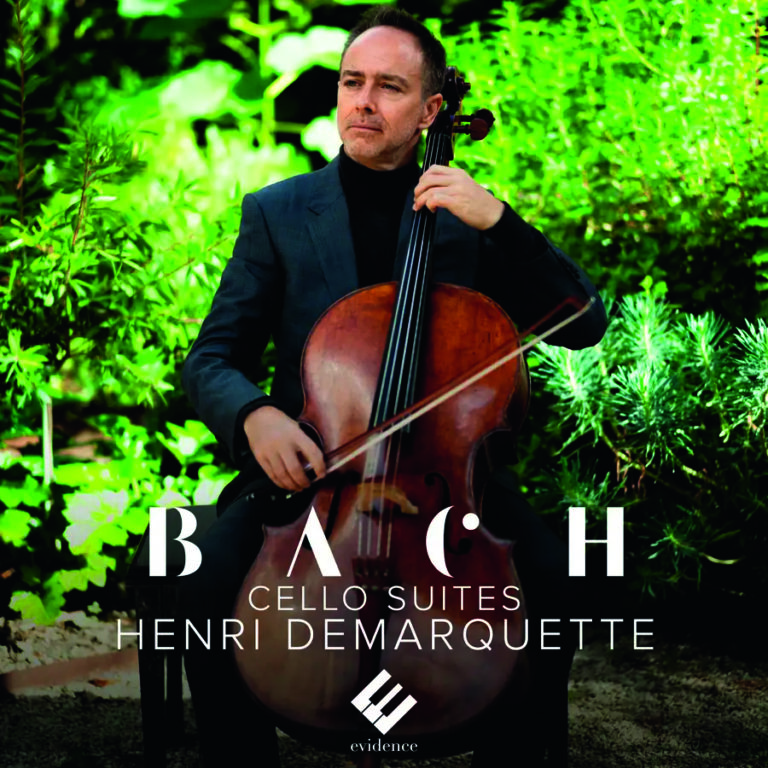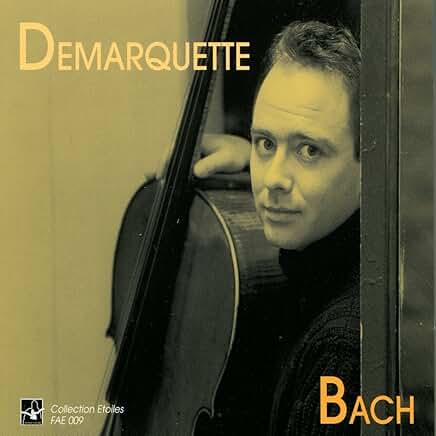
For review of earlier 2002 recording please scroll to the bottom of this page.
Henri Demarquette. Bach Cello Suites.
Evidence Classics EVDCD115. Auditioned Presto streaming 88.2Hz 24Bit.
Recorded from 18th Aug to 21st October & from 28th Nov to first Dec 2022 at la Chapelle du Méjan, Arles.
Demarquette plays a Goffredo Cappa cello dated 1700.
The Cellist.
Demarquette has come in contact with prominent French cellists of the 70s including Gendron, Tortelier, and Fournier. Later in the USA with Janos Starker. As if that was not enough, he was taken under the wing of Yehudi Menuhin whilst in his teens to perform the Dvorak cello concerto!
Clearly a good start to a stellar career.
As well as the usual international career highlights including many premieres of new music, he has branched out into other musical groups, one being Vocello. This is a group of singers and the cello performing modern and renaissance music.
Introduction.
I recommend to the reader and listener, the pamphlet piece titled Rendezvous by Erik Orsenna. Written simply, I find it thought provoking specifically addressing the position the Suites have in the life of any cellist. From reading this, my thoughts are; studying the Suites really is like returning to home, with both familiarity and security, giving a baseline from which to try new ideas. Most of the time an instrumentalist practices pieces written to be accompanied by piano or orchestra, so in that time the outcome is incomplete.
With the Suites more than any other piece I know of, they are complete from the start due to the mastery of Bach’s writing. This means it is possible to vary the interpretation indfinately without needing to communicate to accompanying musicians. The trick for any performer is to ensure that the listener is drawn in and feels engaged as opposed to watching from afar a personal indulgence!
The recording.
This is the second recording of the Suites by Demarquette, the first being released in 2002. This seems a good period of time to develop and change approach. I include a brief overview of this at the end of this review. Mention is made in the recording of the microphone technique used which may be of interest. The end result is a very clear but quite dry acoustic. There is minimal extraneous noise and the cello is well captured with lively dynamics, resonant lower registers and incisive upper registers.
The interpretation.
For the most part, this is a gripping interpretation with speeds on the faster side. There is lots of rubato, very sensitive phrasing, and good rhythmic sense propelling the music onwards. I find the intonation to be superb, which enhances the impression of polyphony in many places especially the faster movements.
The tonal quality is intense and almost abrasive, certainly not sweet. It sounds very much like a modern set up using steel strings There is plenty of legato playing but the faster movements are very well articulated for the most part. I was relieved to find that I was unaware of vibrato. As mentioned earlier, one of Demarquette’s teachers was Maurice Gendron whose recording of the Suites is spoilt for me by very broad and intense vibrato. I must admit to being taken of late by performances with an unforced light airy tonal quality but this recording pulls me back towards the more aggressive, strong, full blooded sound!
Some specifics Suites 1-2.
The first Prelude is a good indicator of what to expect for the whole set of Suites. It starts at what feels like a decent pace with strong assertive tone, and then speeds up almost manically! There is regular slowing of pace followed by further acceleration, almost as if pausing for breath. After a few listens this has started to grow on me! Not sure about the very sustained final note though!
The first Courante is a text book example of very precise articulation coupled with neat phrasing and economic bowing-excellent! The following Sarabande provides a complete contrast with very legato bowing and smooth flowing phrasing aided by skillful ornamentation in the repeats. There is no sense of grinding out chords and lower notes that detracts from other performances.
The Minuets are played in a very rhythmic style with sense of repose in the second which contrasts nicely with the firm articulation of the first.
The gigue completes the first Suite in great style with lovely little pauses between phrases. These enhance listener attention for each phrase without disrupting the sense of momentum.
The second Prelude contrasts well with the first by a more sedate pace and deep sense of yearning. Demarquette has resisted the urge to max out on the tone and displays great sensitivity. The build up to the end is very effective with novel (to me) improvised broken chords . The use of broken chords is not unusual but the modulations are fresh to my ears!
Suite 3.
The third Prelude is played with full on tone and vigour. The intonation is still perfect and the lovely chord sequences in the cross string section come out very well. The Courante is possibly a little rushed in sections with slight loss of definition. The Gigue is played very nimbly and with not too heavy tone. The lower register crossed string section remains well defined which is quite unusual!
Suites 4-5.
The fourth Prelude is one of my favourites to play (badly!) I am pleased to note quite a light approach with leaning in to the lower notes rather than a heavy landing often used by the likes of Maisky!
The fourth Bouree starts with some the most snappy and well-articulated playing of the recording. Every semi-quaver picked out. The second Bouree is a good example of how Demarquette manages to convey phrasing within phrasing. He not only brings out the dance step of each bar but of each four bar section.
In the fifth Prelude, all the qualities previously mentioned produce a sterling performance that allows the listener to savour Bach’s fugal writing in all its glory. Again Demarquette restrains his tone tastefully.
The fifth Allemande flows well and holds ones interest despite its length.
The fifth Sarabande presents with a surprisingly delicate approach and breaks from the legato form used in the other Sarabandes. The notes are separately articulated almost as if the cellist is tip toeing around at night not wanting to disturb sleeping guests! In the second section Demarquette makes a lovely contrast in the repeat by minimising the crescendo in the last line and creating great tension-sublime!
The first three movements of the final Suite present as a superb contrast between the vitality and technical flair of the faster movements with the sensitivity and gentle playing of the Allemande. In this movement there IS sweetness of tone and most effective it is!
The final three movements build from the sedate Sarabande to the final dynamic Gigue via the two perky and rhythmic Gavottes. A thrilling conclusion to the performance!
Conclusion.
Clearly, this is an excellent recording both technically and musically. I would suggest unless you are a hardened Baroque only listener, this should be on your short list. It would make an interesting pairing with the recent recording by de Naverán!
Charles.

Henri Demarquette Bach Cello Suites CD Collection Etoiles 009.
Released 2002 Auditioned on Presto classical streaming CD quality.
Recorded 2-12th July 2001, Église Saint-Clair, Hérouville
On the face of it there is little to distinguish the two recordings from each other apart from 20 years. The style and tempos used are very similar. The total time is 3 minutes shorter than the current release.
However on closer consideration I much prefer the 2024 release for the brighter audio quality, the slightly more sensitive playing and greater finesse. The older recording has a bit more bravado as one would expect from a young soloist in his early 30s. There is more legato playing especially in the fifth Sarabande. There is still excellent articulation in the faster movements but there is a bit of blurring of the sound in the faster passages.
Overall, not a lot to separate the two recordings but a strong personal preference for the 2024 release.
Charles.